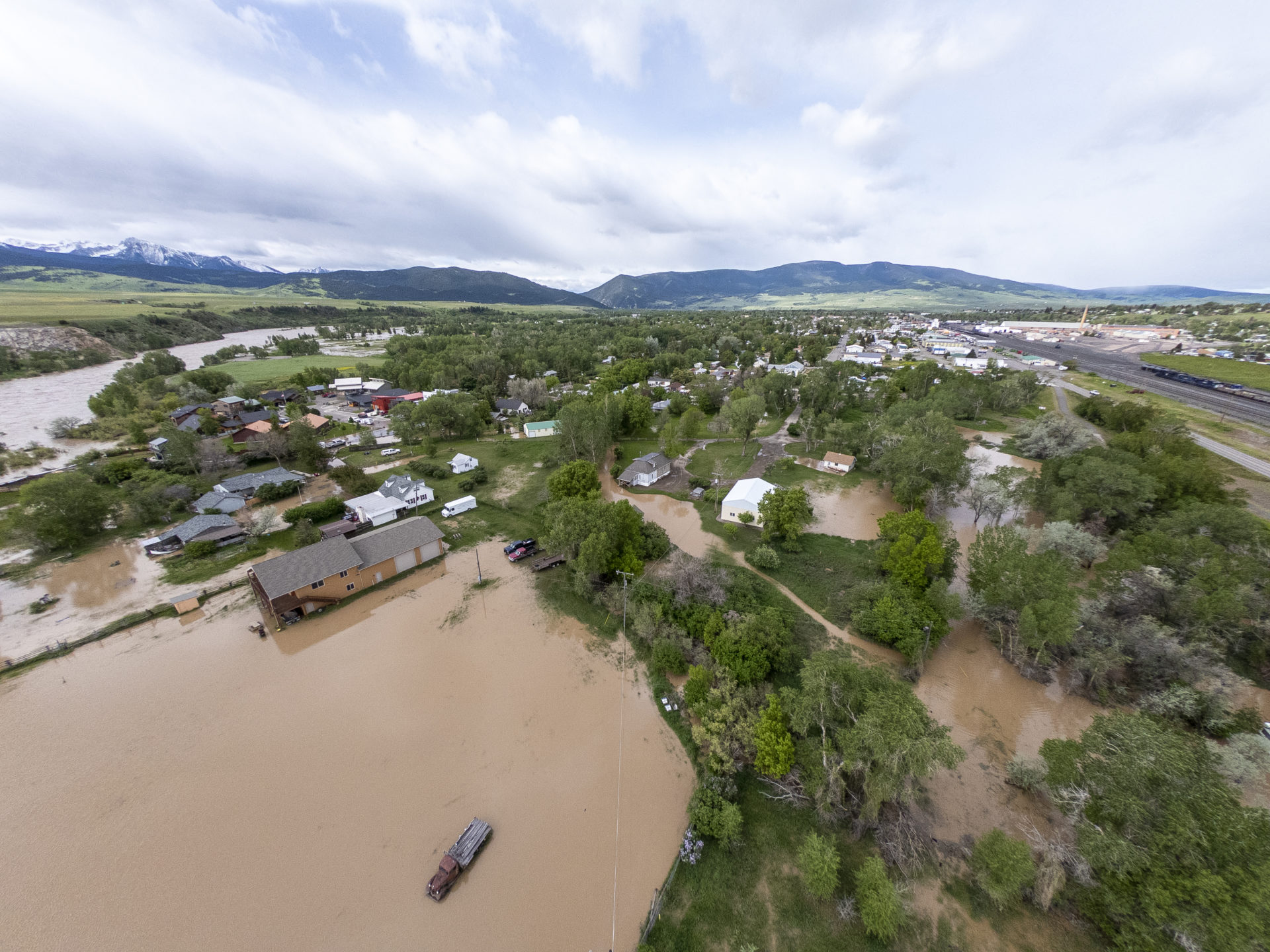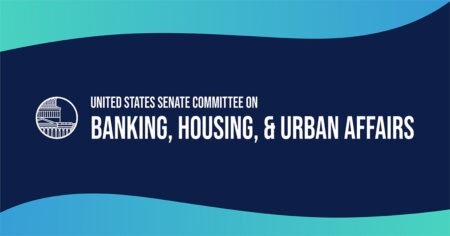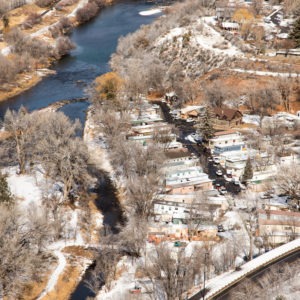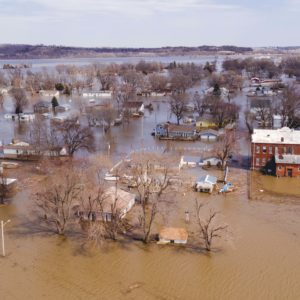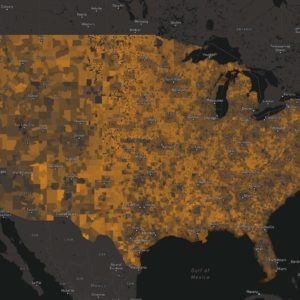The June 2022 floods in southcentral Montana posed significant risk to mobile homes. In Fromberg, Montana, an entire mobile home park was flooded. It could have been much worse. Throughout Montana, more than one in five mobile homes is in a neighborhood with high flood risk.
Flood risk to mobile homes represents a significant threat to housing in Montana. To address this problem, we need better data on the locations of mobile home parks and deliberate efforts to plan and fund flood risk reduction in these areas. (In this post, we use the term “mobile home” to refer to all mobile and manufactured homes. See Definitions below.)
Montana’s mobile home residents face disproportionate risk
Mobile homes are primary sources of affordable housing in the United States, and Montana communities are particularly reliant on them. According to the American Community Survey, 10% of houses in Montana are mobile homes compared to 5.5% in the United States. Some Montana communities have even higher rates. For instance, nearly one-quarter of homes in Fromberg is a mobile home.
Moreover, Montana’s mobile homes have higher flood risk than mobile homes in other places in the United States. Montana ranks fifth in the nation for neighborhoods that have both high flood risk and high mobile home density. An estimated 20% of mobile homes in Montana are located in neighborhoods with high flood risk, compared to 14% of mobile homes in the United States.
Montana ranks fifth in the nation for neighborhoods with high flood risk and high mobile home density.
Too frequently, mobile home residents experience disproportionate impacts from disasters like flooding. When compared to other housing types, mobile home residents have socioeconomic characteristics – such as higher rates of poverty and being more likely to have a disability or mobility issue – that increase their vulnerability to disasters. After a flood, mobile home residents are also more likely to experience barriers to long-term recovery and are more likely to be permanently displaced.
Traditional flood solutions leave mobile home residents behind
Due to the disproportionate risk faced by mobile home residents, it is critical that local and state governments invest in proactive strategies. Traditional solutions to flood risk can be tricky to implement, particularly for mobile home residents who live in mobile home parks and do not own their own land. Mobile home parks are run as commercial businesses, and owners have little financial incentive to invest in projects such as elevating homes that would increase resilience to flooding but detract from profits. This leaves residents with few options to protect themselves from disasters.
Similarly, while property buyouts are one of the most common solutions to decreasing flood risk for other types of housing, federal funding programs do not account for the split ownership structure in most mobile home parks. When a mobile home park is purchased to remove it from the floodplain, the money goes to the commercial owner of the park. There is often little—if any—relocation funding to help the residents move or purchase replacement homes, leaving them with few options when they need help the most.
Further, funding programs that could help pay for communitywide projects to reduce flood risk, such as FEMA’s Building Resilient Infrastructure and Communities grants, tend to favor more populated and wealthier communities, leaving rural and low-capacity places behind.
In Montana, nonprofit organizations have helped fill some of these shortfalls. NeighborWorks Montana helps mobile home park residents purchase their parks so they have control over land use, maintenance, and infrastructure decisions and investments. This is an increasingly common strategy for disaster risk reduction, often supported through state policy changes, with more than 1,000 mobile home parks now owned by residents throughout country.
In Great Falls, NeighborWorks Montana is also helping a resident-owned mobile home park elevate homes above the floodplain, but it took years to secure funding for the project despite its many benefits. More resources and funding to help mobile home residents strengthen their resilience to disasters is clearly needed.
Montana can do more to protect mobile home residents from disasters
Mobile homes are key components of Montana’s current and future affordable housing strategies. New, energy-efficient manufactured homes have been shown to be more resilient to disasters when appropriately sited. For existing mobile homes, coordinated actions are needed at the state and local levels to help mobile home residents decrease their flood risk.
New policies, funding sources, and creative solutions are needed to ensure Montana’s mobile home residents are prepared for future floods.
Strategies available to Montana policymakers include:
1. Create a mobile home park inventory. We do not know the full magnitude of the flood risk to mobile home residents in the state of Montana due to a lack of data. For example, there is not reliable data about how many Montana families live in mobile homes, or where mobile homes are clustered in mobile home parks. Creating an inventory of mobile home parks and their flood risk is an important first step in assessing the problem.
2. Prioritize solutions to mobile home flood risk in hazard mitigation plans. Hazard mitigation plans guide local and state decision-makers in how they prioritize and allocate resources. However, the specific needs of mobile home residents are often not addressed in planning documents. Consequently, critical projects that would benefit mobile home residents can be overlooked. Including solutions for decreasing flood risk to mobile homes in local and state hazard mitigation plans will better position these projects for implementation when funding becomes available.
3. Create new funding sources to protect mobile homes from flood risk. Communities and residents often cannot afford to elevate mobile homes, move them, or buy out mobile home parks on their own. The state can assist by creating new funding sources. For example, another rural state, Vermont, created the Flood Resilient Communities Fund to purchase high-risk properties that do not qualify for FEMA funding, including mobile home parks. The fund was established using COVID-relief funds and could serve as a model for Montana. Similarly, the State of Washington created the Manufactured/Mobile Home Relocation Assistance Program to help mobile home residents move their homes out of the floodplain or find other housing that meets their needs.
The 2022 floods in Montana are a call to action. Many of the places that flooded were areas where residents previously thought flooding was impossible. Southcentral Montana is not the only region in the state where mobile homes have high flood risk. This is a statewide problem. We need new policies, funding sources, and creative solutions to ensure Montana’s mobile home residents are prepared for future floods.
Definitions
In this post, we use the phrase “mobile homes” to refer to all manufactured homes. Mobile and manufactured homes are built on a permanent base frame, enabling them to be moved from the factory to the home site and then relocated as desired. In practice, most manufactured homes are never moved after their initial placement. Manufactured homes include mobile homes, which are technically manufactured homes built before 1976 when HUD began regulating their construction, design, and installation.
The research presented here does not include modular homes. A modular home is partly assembled at a factory and then finished at the building site. Modular homes are regulated like any other site-built home.
